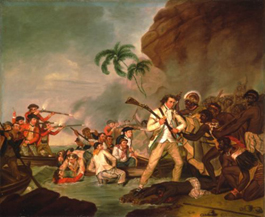Support online education by becoming a member today!
Menu

Much has been written, and debated, about the arrival, impact and death in Hawai‘i of the English explorer Captain James Cook (1728-1779). He and his crew first landed in the Hawaiian Islands in 1778. Cook had voyaged in the Pacific since 1766, mapping and claiming land for the crown on trips that took him to Australia, Aotearoa (New Zealand), Tahiti, Vanuatu and other Oceanic lands. In 1776 his third voyage was launched with the intended purpose of searching for the elusive Northwest Passage across the expansive North American continent. When he came the islands of Hawai‘i he examined and partially surveyed them, eventually landing on Kaua‘i.
It is generally accepted that to some degree Kānaka Maoli of the time viewed and revered Cook as the God Lono arrived from Kahiki to fulfill his makahiki responsibilities. Cook observed and interacted with ali‘i nui and kanaka in religious rituals, sport, dance and other activities. The hired artist on board, John Webber, recorded much of this interaction. Cook eventually left Hawai‘i but a broken mast required that he quickly return. This return, outside of the time set aside for Lono, was met with a much different response. Cook went ashore at Kealakekua Bay in an attempt to retrieve items that he felt were stolen. In his several voyages into the Pacific Cook had developed a “strategy” for interaction with Native peoples that called for strict disciplinary measures at the first sign of trouble. This tact, and his refusal to recognize the sacred rank of the ali‘i nui Kalaniopu‘u, created a situation that resulted in violent confrontation and ultimately Cook‘s death.
Images resulting from this confrontation reveal the important issues surrounding the interpretation and representation of history. Sketches were made at the time of the event but later altered. Official artist on the voyage John Webber was not present during the event and his illustration moves the scene and adds other dramatic effects. The images that were later created from this work displayed several different storylines ranging from Cook as a peacemaker to a recently discovered 19th-century painting by John Cleveley that illustrated him as a violent instigator.
Cook’s overall legacy is also varied. Many have honored him as a great explorer, navigator, and cartographer. Statues of him stand at sites ranging from England to Australia to Kaua‘i, and Cook appeared on a 1928 U.S. coin celebrating the 150th anniversary of his “discovery” of the islands. He is conversely seen by some as the epitome of imperialistic policies of European countries. These nations viewed the world as Terra nullius, essentially land that was empty of “real” human life and therefore open to be claimed by the crown. This interpretation of his legacy also includes many of the diseases that would come to devastate the Hawaiian population. Further, his naming of the islands in honor of the Earl of Sandwich completely dismisses the understanding that the islands already possessed names that carried important historical and spiritual meaning to the inhabitants who had lived there for centuries prior. Long-held parades and celebrations honoring the “discoveries” of European explorers like Cook, Columbus and others, are often being challenged and labeled as attempts to erase the histories and accomplishments of previous civilizations in these lands.
Death of Captain Cook.Oil on canvas by George Carter, ca. 1783 (76x91cm).
Location: Bishop Museum Archives
Collection: Art Collection
Call Number: Art. People. Cook.

Image from Bishop Museum Archives, Honolulu, Hawaii. Images are not to be re-used without permission.
Collection: Art Collection
Call Number: Art. People. Cook.
Location: Bishop Museum Archives

Image from Bishop Museum Archives, Honolulu, Hawaii. Images are not to be re-used without permission.
Captain Cook Monument at Kealakekua Bay, Kona, Hawai‘i.
Collection: General Photograph Collection
Call Number: Geography. Hawai‘i. Kealakekua. Cook Monument.
Location: Bishop Museum Archives

Image from Bishop Museum Archives, Honolulu, Hawaii. Images are not to be re-used without permission.
“A View of Karakakooa, in Owyhee.” 1784.
Engraving by W. Byrne after the artist John Webber.
from: James Cook, “A Voyage to the Pacific Ocean…in the Years 1776-1780.” London: 1784, pl. 68.
Collection: Art Collection
Call Number: Art. Geography. Hawai‘i. Kealakekua.
Location: Bishop Museum Archives

Image from Bishop Museum Archives, Honolulu, Hawaii. Images are not to be re-used without permission.
An Offering Before Cook in the Sandwich Islands. 1779. Ink and watercolor wash by John Webber.
Collection: Art Collection
Call Number: Art. Ethnic Culture. Hawaiian. Religion.
Location: Bishop Museum Archives